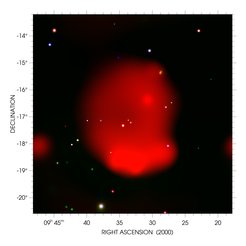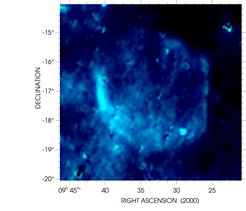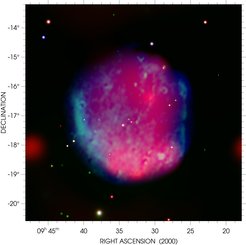Hoinga – the largest supernova remnant ever discovered with X-rays
In the first all-sky survey by the eROSITA X-ray telescope onboard SRG, astronomers at the Max Planck Institute for Extraterrestrial Physics have identified a previously unknown supernova remnant, dubbed “Hoinga.” The finding was confirmed in archival radio data and marks the first discovery of a joint Australian-eROSITA partnership established to explore our Galaxy using multiple wavelengths, from low-frequency radio waves to energetic X-rays. The Hoinga supernova remnant is very large and located far from the galactic plane – a surprising first finding – implying that the next years might bring many more discoveries.

Cut-out of the first SRG/eROSITA all-sky survey. The Hoinga supernova remnant is marked. The large bright source in the lower quadrant of the image is from the supernova remnant “Vela” with “Pupis-A”. The image colours are correlated with the energies of the detected X-ray photons. Red represents the 0.3-0.6 keV energy range, green 0.6-1.0 keV and blue 1.0-2.3 keV.
Massive stars end their lives in gigantic supernova explosions when the fusion processes in their interiors no longer produce enough energy to counter their gravitational collapse. But even with hundreds of billions of stars in a galaxy, these events are pretty rare. In our Milky Way, astronomers estimate that a supernova should happen on average every 30 to 50 years. While the supernova itself is only observable on a timescale of months, its remnants can be detected for about 100,000 years. These remnants are composed of the material ejected by the exploding star at high velocities and form shocks when hitting the surrounding interstellar medium.
About 300 such supernova remnants are known today – much fewer than the estimated 1,200 that should be observable throughout our home Galaxy. So, either astrophysicists have misunderstood the supernova rate, or a large majority has been overlooked so far. An international team of astronomers is now using the all-sky scans of the eROSITA X-ray telescope to look for previously unknown supernova remnants. With temperatures of millions of the degrees, the debris of such supernovae emits high-energy radiation, i.e., they should show up in the high-quality X-ray survey data.

Close-up of the Hoinga supernova remnant as seen in the first eROSITA all-sky survey. Photons to produce this 7.5 x 7.5 degrees image were colour-coded according to their energy (red for energies 0.2 - 0.7 keV, green for 0.7 - 1.2 keV, blue for 1.2 - 2.4 keV). Almost the entire X-ray emission from the remnant is observed at energies between 0.2 - 0.7 keV. The image was smoothed to better enhance the visibility of the diffuse X-ray emission.
“We were very surprised that the first supernova remnant popped up straight away,” says Werner Becker at the Max Planck Institute for Extraterrestrial Physics. “Hoinga” is the largest supernova remnant ever discovered in X-rays. With a diameter of about 4.4 degrees, it covers an area that is about 90 times bigger than the full moon. “Moreover, it lies very far off the galactic plane, which is very unusual,” he adds. Most previous searches for supernova remnants have concentrated on the disk of our Galaxy, where star formation activity is highest and stellar remnants therefore should be more numerous, but it seems that many supernova remnants have been overlooked by this search strategy.

Composite image of Hoinga taken at 1.4 GHz and 2.3 GHz by the CHIPASS and SPASS radio surveys. The blue colour is arbitrary; fore- and background sources were removed from the images to increase the visibility of the diffuse radio emission from the supernova remnant.
After the astronomers found the object in the eROSITA all-sky data, they turned to other resources to confirm its nature. Hoinga is – although barely – visible also in data taken by the ROSAT X-ray telescope 30 years ago, but nobody noticed it before due to its faintness and its location at high galactic latitude. However, the real confirmation came from radio data, the spectral band where 90% of all known supernova remnants were found so far.
“We went through archival radio data and it had been sitting there, just waiting to be discovered,” marvels Natasha Walker-Hurley from the Curtin University node of the International Center for Radio Astronomy Research in Australia. “The radio emission in 10-year-old surveys clearly confirmed that Hoinga is a supernova remnant, so there may be even more of these out there waiting for keen eyes.”

Composite X-ray and radio image of Hoinga (see also Fig.2 and Fig.3). The X-rays discovered by eROSITA are emitted by the hot debris of the exploded progenitor, whereas the radio antennae detect synchrotron emission from relativistic electrons, which are decelerated at the outer remnant layer.
The eROSITA X-ray telescope will perform a total of eight all-sky surveys and is about 25 times more sensitive than its predecessor ROSAT. Both observatories were designed, built, and are operated by the Max Planck Institute for Extraterrestrial Physics. The astronomers expected to discover new supernova remnants in X-ray data over the next few years, but they were surprised to identify one so early in the program. Combined with the fact that the signal is already present in decades-old data, this implies that many supernova remnants might have been overlooked in the past due to low-surface brightness, unusual locations, or because of other nearby emission from brighter sources. Together with upcoming radio surveys, the eROSITA X-ray survey shows great promise for finding many of the missing supernova remnants, helping to solve this long-standing astrophysical mystery.
Notes
1. The name Hoinga for the supernova remnant was chosen in honor of the first author’s hometown: Hoinga was the medieval name of Bad Hönningen am Rhein.
2. On June 11, 2020, the eROSITA telescope completed its first survey of the entire X-ray sky. Launched on July 13, 2019 on-board the SRG spacecraft and now orbiting the second Lagrange point of the earth-sun system, the telescope is in continuous scanning mode. eROSITA is the primary instrument aboard SRG, a joint Russian-German science mission supported by the Russian Space Agency (Roskosmos), in the interests of the Russian Academy of Sciences represented by its Space Research Institute (IKI), and the Deutsches Zentrum für Luft- und Raumfahrt (DLR). The development and construction of the eROSITA X-ray instrument was led by the Max Planck Institute for Extraterrestrial Physics (MPE), with contributions from the Dr. Karl Remeis Observatory Bamberg, the University of Hamburg Observatory, the Leibniz Institute for Astrophysics Potsdam (AIP), and the Institute for Astronomy and Astrophysics of the University of Tübingen, with the support of DLR and the Max Planck Society. The Argelander Institute for Astronomy of the University of Bonn and the Ludwig-Maximilians-Universität Munich also participated in the science preparation for eROSITA.















